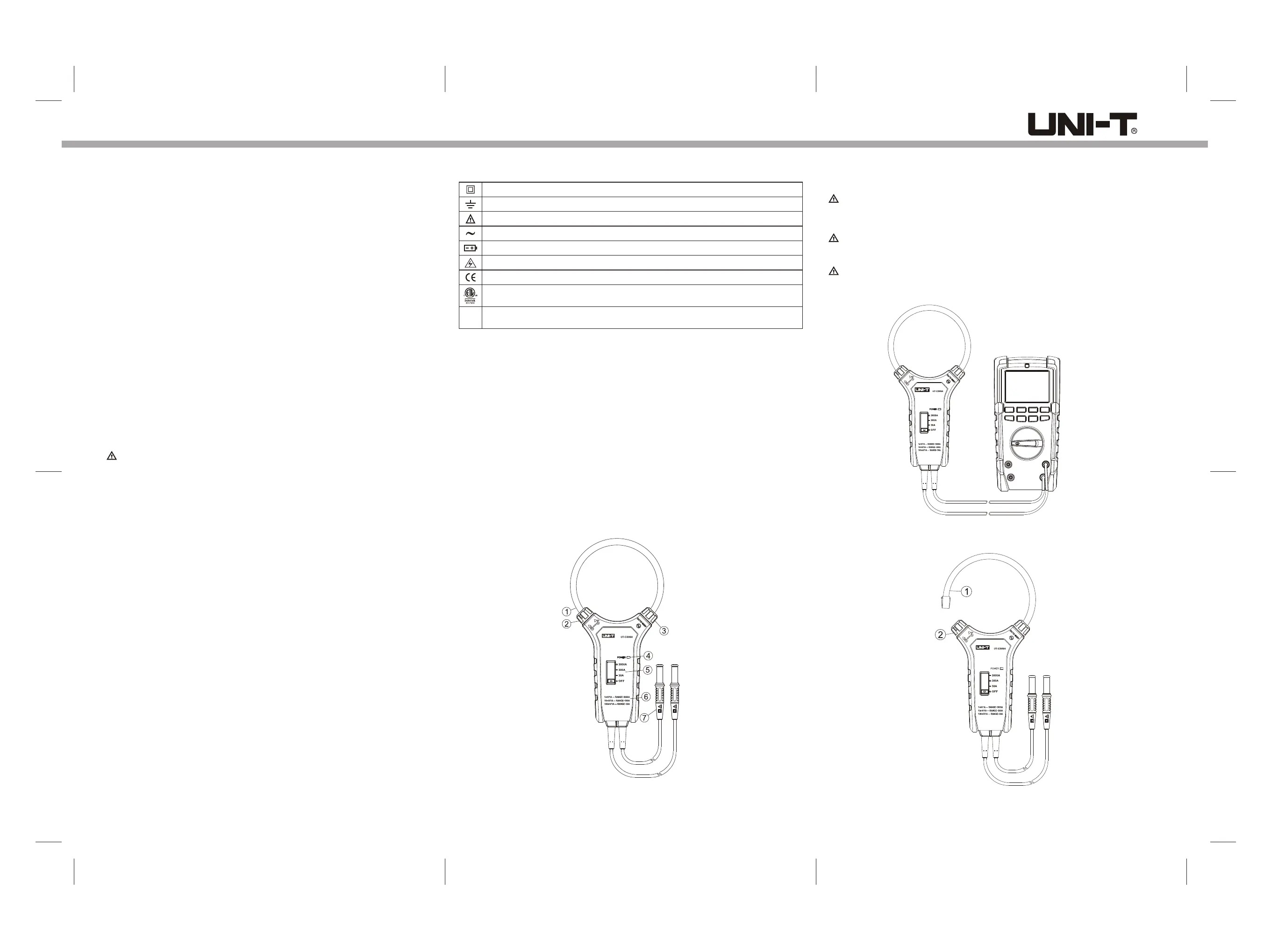Instrukcja obsługi Uni-T UT-CS09D
Uni-T
Sprzęt pomiarowy
UT-CS09D
Przeczytaj poniżej 📖 instrukcję obsługi w języku polskim dla Uni-T UT-CS09D (4 stron) w kategorii Sprzęt pomiarowy. Ta instrukcja była pomocna dla 27 osób i została oceniona przez 14 użytkowników na średnio 5.0 gwiazdek
Strona 1/4

UT-CS09A/D
Flex Clamp Current Sensor
Thank you for purchasing this brand new UNI-T product. In order to safely and correctly use this
device, please read this manual carefully, especially the Safety Instructions section.
Please keep the manual accessible near the device for future reference.
1. Introduction
2. Open Box Inspection
3. Safety Instructions
4. Symbols
5. Structure
6. Operation Instructions
7. Technical Specifications
A. General specifications
B. Operating environment
C. Electric specifications
8.Maintenance
A. General maintenance
B. Battery installation & replacement
1. Instruction
UT-CS09A/UT-CS09D is a stable, safe and reliable 3000A AC Rogowski flex Clamp Current Sensor
(hereinafter called current sensor). The core of the design is the Rogowski coil.
Warning:
To avoid electric shock or injury, please read Safety Instructions and Warnings before operating this
product.
2. Open Box Inspection
Open the package box and take out the device. Please check whether the following items are deficient
or damaged and contact your supplier immediately if they are.
User manual ----------------------- 1
BNC adapter------------------------ 1 pc
Battery: 1.5V AAA----------------- 3 pc
pc
3. Safety Instructions
In this manual, a Warning identifies conditions and actions that pose hazard(s) to the user or the
test device.
This device strictly follows CE standards: IEC61010-1; IEC61010-031; IEC61010-2-032 as well as
CAT IV 600V, RoHS, pollution grade II, and double insulation standards.
If the clamp is used in a manner that is not specified in this manual, the protection provided by the
device might be impaired.
1) Do not use the device if the rear cover or the battery cover is not covered up.
2) When measuring, keep fingers behind the finger guard on the measuring head. Do not touch
bare cables, connectors, unoccupied input terminals or circuit being measured.
3) Before measuring, the switch should be on correct position. Do not switch positions during
measurement.
4) Do not use the clamp on any conductor with voltages higher than DC 1000V or AC 750V.
5) Use caution when working with voltages above 33V AC rms. Such voltages pose shock hazard.
6) Do not use the device to measure current higher than specified range. If current value being
measured is unknown, select 3000A position and reduce accordingly.
7) To avoid false reading, replace the battery if “POWER” indicator flashes. Remove the battery
if the sensor is left unused for a long time.
8) Do not change the internal circuit of the device.
9) Do not store or use the sensor in high temperature, high humidity, explosive, or strong magnetic
field environments.
10) Use soft cloth to clean the case, do not use abradants or solvents.
11) Do not use when the jaw or "jaw end" is worn.
Double insulation
Grounding
Warning
AC (Alternating Current)
Battery
High voltage hazard
Comply with European Union standards
Conforms to UL STD. 61010-1, 61010-2-032, 61010-031,
Certified to CSA STD. C22.2 No. 61010-1, 61010-2-032, 61010-031.
It is applicable to test and measuring circuits connected at the source of the building’s
low-voltage MAINS installation.
4. Symbols
CAT IV
5.Structure
1. Flexible Rogowski coil
2. Flexible clamp lock
Rotate the knob according to the arrow mark on the case to lock or unlock
3. Fixed piece
4. Power indicator
Normal status: constant red light
Low power (<3.3V): flash once for every 1s period. Please replace the batteries.
5. Switch
A. 30A
For measuring 1.5A~30A
B. 300A
For measuring 30A~300A
C. 3000A
For measuring 300A~3000A
D. OFF
Switch off the sensor
6. Corresponding output voltage
A. 30A range: 1A -> 100mV
B. 300A range: 1A -> 10mV
C. 3000A range: 1A -> 1mV
7. Voltage signal output terminal
The corresponding voltage output of AC current measured through flexible current sensor.
6.Operations
BNC terminal can be used to connect flexible current sensor to read out on oscilloscope
Warnings:
To avoid false reading, do not use low input impedance settings when using oscilloscopes as readouts.
AC measurement
Warning:
Before measuring, switch off the conductor to be measured. Do not turn on the conductor before the sensor
is locked around the conductor to be measured.
Caution:
Keep your hands away from the Rogowski ring and conductor to be measured.
1.Connect the sensor with alternating voltage measure device e.g. multimeter. (see figure 2)
Figure 2
Figure 1
2. Unlock the Rogowski coil according to (see figure 3).Section 5.2
Figure 3
Flex Clamp
Current Sensor
Flex Clamp
Current Sensor
Flex Clamp
Current Sensor
P/N:110401109668X
Specyfikacje produktu
| Marka: | Uni-T |
| Kategoria: | Sprzęt pomiarowy |
| Model: | UT-CS09D |
Potrzebujesz pomocy?
Jeśli potrzebujesz pomocy z Uni-T UT-CS09D, zadaj pytanie poniżej, a inni użytkownicy Ci odpowiedzą
Instrukcje Sprzęt pomiarowy Uni-T

3 Kwietnia 2025

3 Kwietnia 2025

3 Kwietnia 2025

3 Kwietnia 2025

3 Kwietnia 2025

3 Kwietnia 2025

3 Kwietnia 2025

3 Kwietnia 2025

3 Kwietnia 2025

3 Kwietnia 2025
Instrukcje Sprzęt pomiarowy
- LaCie
- Crowcon
- Senseca
- Softing
- Shimano
- Lanaform
- Sekonic
- Atmel
- Topcom
- PQ Plus
- ClimeMET
- Sanwa
- Seaward
- PCE Instruments
- Ridgid
Najnowsze instrukcje dla Sprzęt pomiarowy

1 Kwietnia 2025

1 Kwietnia 2025

1 Kwietnia 2025

1 Kwietnia 2025

1 Kwietnia 2025

1 Kwietnia 2025

1 Kwietnia 2025

1 Kwietnia 2025

1 Kwietnia 2025

1 Kwietnia 2025